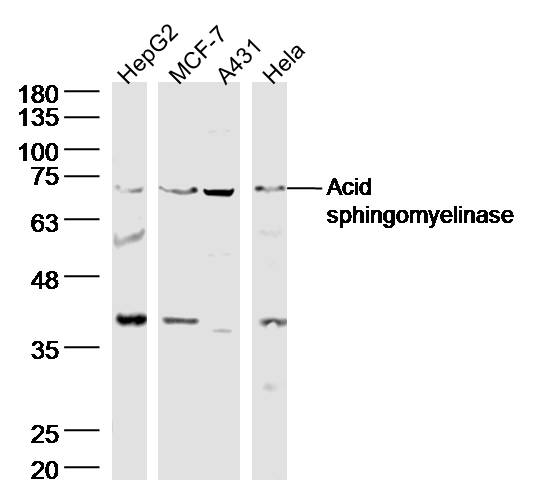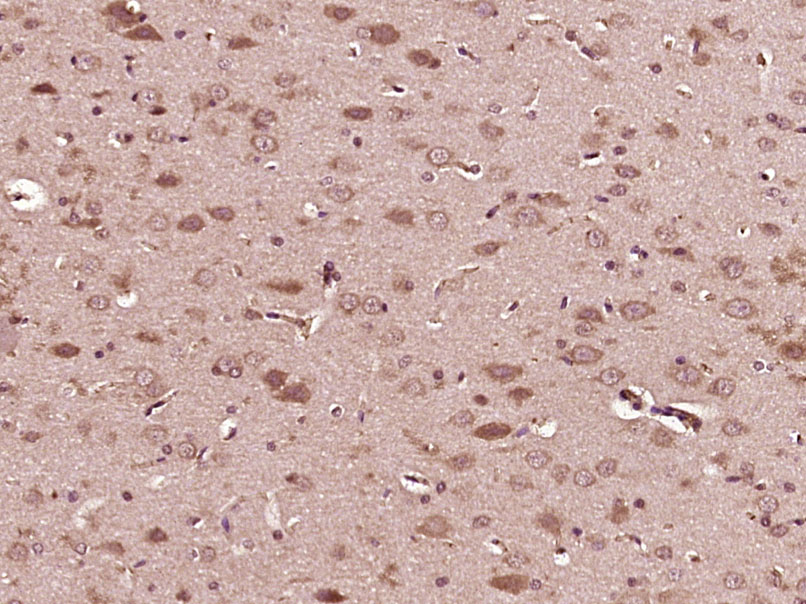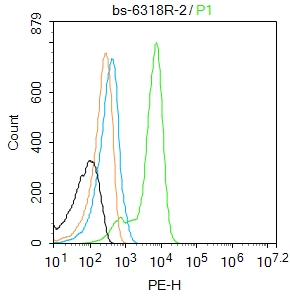
Rabbit Anti-Acid sphingomyelinase antibody
Acid sphingomyelinase; ASM; ASM_HUMAN; aSMase; NPD; Smpd1; Sphingomyelin phosphodiesterase 1 acid lysosomal; Sphingomyelin phosphodiesterase.
View History [Clear]
Details
Product Name Acid sphingomyelinase Chinese Name 酸性神经鞘磷脂酶抗体 Alias Acid sphingomyelinase; ASM; ASM_HUMAN; aSMase; NPD; Smpd1; Sphingomyelin phosphodiesterase 1 acid lysosomal; Sphingomyelin phosphodiesterase. literatures Research Area Cell biology Neurobiology Signal transduction Apoptosis Immunogen Species Rabbit Clonality Polyclonal React Species Human, Mouse, Rat, (predicted: Dog, Pig, Cow, Rabbit, ) Applications WB=1:500-2000 ELISA=1:5000-10000 IHC-P=1:100-500 IHC-F=1:100-500 Flow-Cyt=2ug/Test ICC=1:100-500 IF=1:100-500 (Paraffin sections need antigen repair)
not yet tested in other applications.
optimal dilutions/concentrations should be determined by the end user.Theoretical molecular weight 64kDa Cellular localization cytoplasmic Form Liquid Concentration 1mg/ml immunogen KLH conjugated synthetic peptide derived from human Acid sphingomyelinase: 201-300/629 Lsotype IgG Purification affinity purified by Protein A Buffer Solution 0.01M TBS(pH7.4) with 1% BSA, 0.03% Proclin300 and 50% Glycerol. Storage Shipped at 4℃. Store at -20 °C for one year. Avoid repeated freeze/thaw cycles. Attention This product as supplied is intended for research use only, not for use in human, therapeutic or diagnostic applications. PubMed PubMed Product Detail Converts sphingomyelin to ceramide. Also has phospholipase C activities toward 1,2-diacylglycerolphosphocholine and 1,2-diacylglycerolphosphoglycerol. Isoform 2 and isoform 3 have lost catalytic activity.
Involvement in disease: Defects in SMPD1 are the cause of Niemann-Pick disease type A (NPDA) ; also known as Niemann-Pick disease classical infantile form. It is an early-onset lysosomal storage disorder caused by failure to hydrolyze sphingomyelin to ceramide. It results in the accumulation of sphingomyelin and other metabolically related lipids in reticuloendothelial and other cell types throughout the body, leading to cell death. Niemann-Pick disease type A is a primarily neurodegenerative disorder characterized by onset within the first year of life, mental retardation, digestive disorders, failure to thrive, major hepatosplenomegaly, and severe neurologic symptoms. The severe neurological disorders and pulmonary infections lead to an early death, often around the age of four. Clinical features are variable. A phenotypic continuum exists between type A (basic neurovisceral) and type B (purely visceral) forms of Niemann-Pick disease, and the intermediate types encompass a cluster of variants combining clinical features of both types A and B.
Function:
Converts sphingomyelin to ceramide. Also has phospholipase C activities toward 1,2-diacylglycerolphosphocholine and 1,2-diacylglycerolphosphoglycerol. Isoform 2 and isoform 3 have lost catalytic activity.
Subunit:
Monomer.
Subcellular Location:
Lysosome.
DISEASE:
Defects in SMPD1 are the cause of Niemann-Pick disease type A (NPDA) [MIM:257200]; also known as Niemann-Pick disease classical infantile form. It is an early-onset lysosomal storage disorder caused by failure to hydrolyze sphingomyelin to ceramide. It results in the accumulation of sphingomyelin and other metabolically related lipids in reticuloendothelial and other cell types throughout the body, leading to cell death. Niemann-Pick disease type A is a primarily neurodegenerative disorder characterized by onset within the first year of life, mental retardation, digestive disorders, failure to thrive, major hepatosplenomegaly, and severe neurologic symptoms. The severe neurological disorders and pulmonary infections lead to an early death, often around the age of four. Clinical features are variable. A phenotypic continuum exists between type A (basic neurovisceral) and type B (purely visceral) forms of Niemann-Pick disease, and the intermediate types encompass a cluster of variants combining clinical features of both types A and B.
Defects in SMPD1 are the cause of Niemann-Pick disease type B (NPDB) [MIM:607616]; also known as Niemann-Pick disease visceral form. It is a late-onset lysosomal storage disorder caused by failure to hydrolyze sphingomyelin to ceramide. It results in the accumulation of sphingomyelin and other metabolically related lipids in reticuloendothelial and other cell types throughout the body, leading to cell death. Clinical signs involve only visceral organs. The most constant sign is hepatosplenomegaly which can be associated with pulmonary symptoms. Patients remain free of neurologic manifestations. However, a phenotypic continuum exists between type A (basic neurovisceral) and type B (purely visceral) forms of Niemann-Pick disease, and the intermediate types encompass a cluster of variants combining clinical features of both types A and B. In Niemann-Pick disease type B, onset of the first symptoms occurs in early childhood and patients can survive into adulthood.
Similarity:
Belongs to the acid sphingomyelinase family.
Contains 1 saposin B-type domain.
SWISS:
P17405
Gene ID:
6609
Database links:
Entrez Gene: 100720041 Guinea pig
Entrez Gene: 6609 Human
Entrez Gene: 20597 Mouse
Entrez Gene: 100353898 Rabbit
Omim: 607608 Human
SwissProt: P17405 Human
SwissProt: Q04519 Mouse
Unigene: 498173 Human
Unigene: 4628 Mouse
Unigene: 485064 Mouse
Unigene: 18277 Rat
ASM酸性神经鞘磷脂酶是ASMase神经鞘磷脂酶最重要的一个亚型,是The cell membrane的重要组成成分。ASM在Apoptosis、调节Tumour细胞生长、参与Fas信号系统传递等方面均可发挥重要作用。Product Picture
HepG2(human) cell Lysate at 30 ug
MCF-7(human) cell Lysate at 30 ug
A431(human) cell Lysate at 30 ug
Hale(human) cell Lysate at 30 ug
Primary: Anti- Acid sphingomyelinase (SL6318R) at 1/300 dilution
Secondary: IRDye800CW Goat Anti-Rabbit IgG at 1/20000 dilution
Predicted band size: 64kD
Observed band size: 69 kD
Paraformaldehyde-fixed, paraffin embedded (Rat brain); Antigen retrieval by boiling in sodium citrate buffer (pH6.0) for 15min; Block endogenous peroxidase by 3% hydrogen peroxide for 20 minutes; Blocking buffer (normal goat serum) at 37°C for 30min; Antibody incubation with (Acid sphingomyelinase) Polyclonal Antibody, Unconjugated (SL6318R) at 1:400 overnight at 4°C, followed by operating according to SP Kit(Rabbit) (sp-0023) instructionsand DAB staining.Blank control:A431.
Primary Antibody (green line): Rabbit Anti-Acid sphingomyelinase antibody (SL6318R)
Dilution: 2μg /10^6 cells;
Isotype Control Antibody (orange line): Rabbit IgG .
Secondary Antibody : Goat anti-rabbit IgG-AF488
Dilution: 1μg /test.
Protocol
The cells were fixed with 4% PFA (10min at room temperature)and then permeabilized with 0.1% PBST for 20 min at room temperature.The cells were then incubated in 5%BSA to block non-specific protein-protein interactions for 30 min at room temperature .Cells stained with Primary Antibody for 30 min at room temperature. The secondary antibody used for 40 min at room temperature. Acquisition of 20,000 events was performed.
References (0)
No References
Bought notes(bought amounts latest0)
No one bought this product
User Comment(Total0User Comment Num)
- No comment





 +86 571 56623320
+86 571 56623320
 +86 18668110335
+86 18668110335

